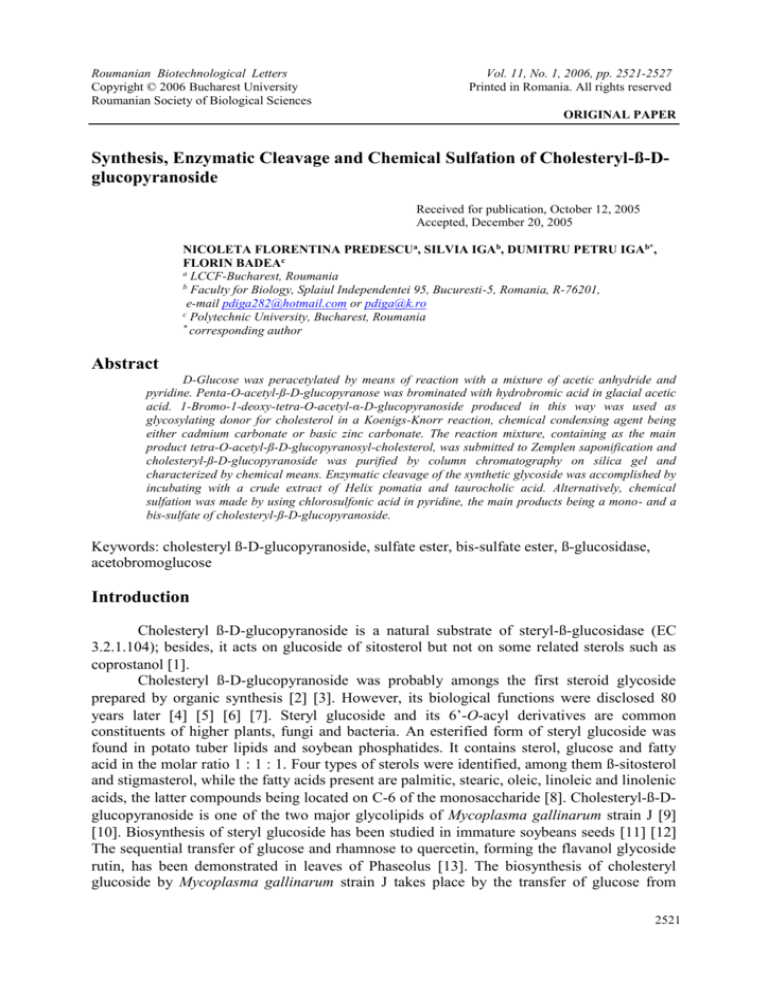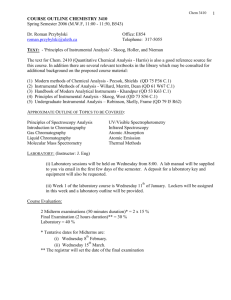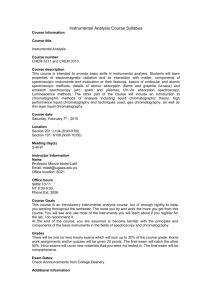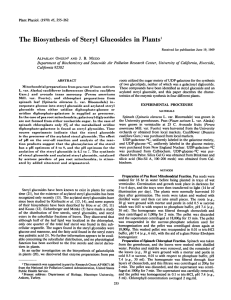
Roumanian Biotechnological Letters
Copyright © 2006 Bucharest University
Roumanian Society of Biological Sciences
Vol. 11, No. 1, 2006, pp. 2521-2527
Printed in Romania. All rights reserved
ORIGINAL PAPER
Synthesis, Enzymatic Cleavage and Chemical Sulfation of Cholesteryl-ß-Dglucopyranoside
Received for publication, October 12, 2005
Accepted, December 20, 2005
NICOLETA FLORENTINA PREDESCUa, SILVIA IGAb, DUMITRU PETRU IGAb*,
FLORIN BADEAc
a
LCCF-Bucharest, Roumania
b
Faculty for Biology, Splaiul Independentei 95, Bucuresti-5, Romania, R-76201,
e-mail pdiga282@hotmail.com or pdiga@k.ro
c
Polytechnic University, Bucharest, Roumania
*
corresponding author
Abstract
D-Glucose was peracetylated by means of reaction with a mixture of acetic anhydride and
pyridine. Penta-O-acetyl-ß-D-glucopyranose was brominated with hydrobromic acid in glacial acetic
acid. 1-Bromo-1-deoxy-tetra-O-acetyl-α-D-glucopyranoside produced in this way was used as
glycosylating donor for cholesterol in a Koenigs-Knorr reaction, chemical condensing agent being
either cadmium carbonate or basic zinc carbonate. The reaction mixture, containing as the main
product tetra-O-acetyl-ß-D-glucopyranosyl-cholesterol, was submitted to Zemplen saponification and
cholesteryl-ß-D-glucopyranoside was purified by column chromatography on silica gel and
characterized by chemical means. Enzymatic cleavage of the synthetic glycoside was accomplished by
incubating with a crude extract of Helix pomatia and taurocholic acid. Alternatively, chemical
sulfation was made by using chlorosulfonic acid in pyridine, the main products being a mono- and a
bis-sulfate of cholesteryl-ß-D-glucopyranoside.
Keywords: cholesteryl ß-D-glucopyranoside, sulfate ester, bis-sulfate ester, ß-glucosidase,
acetobromoglucose
Introduction
Cholesteryl ß-D-glucopyranoside is a natural substrate of steryl-ß-glucosidase (EC
3.2.1.104); besides, it acts on glucoside of sitosterol but not on some related sterols such as
coprostanol 1.
Cholesteryl ß-D-glucopyranoside was probably amongs the first steroid glycoside
prepared by organic synthesis 2 3. However, its biological functions were disclosed 80
years later 4 5 6 7. Steryl glucoside and its 6’-O-acyl derivatives are common
constituents of higher plants, fungi and bacteria. An esterified form of steryl glucoside was
found in potato tuber lipids and soybean phosphatides. It contains sterol, glucose and fatty
acid in the molar ratio 1 : 1 : 1. Four types of sterols were identified, among them ß-sitosterol
and stigmasterol, while the fatty acids present are palmitic, stearic, oleic, linoleic and linolenic
acids, the latter compounds being located on C-6 of the monosaccharide 8. Cholesteryl-ß-Dglucopyranoside is one of the two major glycolipids of Mycoplasma gallinarum strain J 9
10. Biosynthesis of steryl glucoside has been studied in immature soybeans seeds 11 12
The sequential transfer of glucose and rhamnose to quercetin, forming the flavanol glycoside
rutin, has been demonstrated in leaves of Phaseolus 13. The biosynthesis of cholesteryl
glucoside by Mycoplasma gallinarum strain J takes place by the transfer of glucose from
2521
NICOLETA FLORENTINA PREDESCU, SILVIA IGA, DUMITRU PETRU IGA, FLORIN BADEA
uridine-5'-diphosphoglucose to membrane-bound sterol 14. It was demonstrated by feeding
D-[14C]glucose at Borrelia hermsi, that labeled glucose was incorporated into cholesteryl
glucoside and acylated cholesteryl glucoside 15. A mixture containg predominantly the ßanomer of diosgenin glucoside and a small amount of yamogenin glucoside was synthesized
and its effects on cholesterol homeostasis in monkeys (Macaca fascicularis) were tested. The
respective mixture, containing mainly diosgenin glucoside, reduced cholesterolemia,
decreased intestinal absorption of exogenous cholesterol and increased secretion of
endogenous cholesterol. It was demonstrated that the glucoside was well tolerated when longterm studies were undertaken, no toxic signs being observed. An interesting conclusion has
been drawn: diosgenin glucoside and other synthetic glycosides with similar activities could
be used in the management of hypercholesterolemia and atherosclerosis 16. Three kinds of
glycolipids, accounting for about 25% of the total lipid, were identified in a lipidic extract
from Helicobacter pylori, their structures being cholesteryl-α-D-glucopyranoside, cholesteryl6-O-tetradecanoyl-α-D-glucopyranoside
and
cholesteryl-6-O-phosphatidyl-α-Dglucopyranoside 17. Beta-glucosidase is an important microbial taxonomic marker, an
excellent substrate being cyclohexenoesculetin-ß-D-glucoside 18. Two glycosides,
sitosteryl-D-glucoside and stigmasteryl-D-glucoside, were isolated from the fresh fruit of
Annona glabra and characterized by physical and spectral evidence 19.
In the present paper, cholesteryl-ß-D-glucopyranoside has been synthesized by ,eans
of a Koenigs-Knorr reaction of 1-bromo-1-deoxy-tetra-O-acetyl-glucopyranoside in the
presence of either cadmium carbonate or basic zinc carbonate, as promoters, followed by mild
alkaline hydrolysis and column chromatography. Orthoester formation was ruled out by
enzymatic cleavage of reaction product by a crude ß-galactosidase from snail Helix pomatia.
Alternatively, cholesteryl-ß-D-glucopyranoside has been sulfated with chlorosulfonic acid in
pyridine, a monosulfate and a bis-sulfate being obtained.
Materials and Methods
Materials. Cholesterol, glucose, acetic anhydride, pyridine, chlorosulfonic acid,
silicagel for column chromatography, precoated thin layer plates, florisil, were either from
Merck or from Fluka.
Methods. 1. Penta-O-acetyl-ß-D-glucopyranoside was synthesized as indicated
LEMIEUX 20. In a 0.25-L, 3-necked flask equipped with a magnetic stirrer and a
thermometer, 40 mL of acetic anhydride was cooled in an ice and water mixture, and 0,24 mL
of 70 % perchloric acid was added dropwise. The solution was then warmed to room
temperature, and 10 g of anhydrous D-glucose was added to the stirred mixture at such a rate
to keep the reaction temperature between 30 and 40 0C. At the end of the reaction, ice and
chloroform were added in the reaction mixture, organic layer was separated and washed three
times successively with small volumes of saturated sodium bicarbonate solution and then with
water. Organic layer was then dried on magnesium sulfate, filtered and concentrated to
dryness by rotavapor. The reaction product, penta-O-acetyl-ß-D-glucopyranoside, was
purified by crystallysation from ethanol.
2. 1-Bromo-1-deoxi-2,3,4,6-tetra-O-acetyl-α-D-glucopyranoside was synthesized
from 2.9 g penta-O-acetyl-ß-D-glucopyranoside and hydrobromic acid according to
LEMIEUX 20 : a sample of 32-33 % solution of hydrobromic acid in dry acetic acid was
placed in a flask protected against humidity and cooled on ice. Then penta-O-acetyl-ß-Dglucopyranoside and 1,2-dichloroethane were added and the reaction was run on ice and
subsequently at room temperature. Bromoderivative was extracted with cold chloroform,
2522
Roum. Biotechnol. Lett., Vol. 11, No. 1, 2521-2527 (2006)
Synthesis, Enzymatic Cleavage and Chemical Sulfation of Cholesteryl-ß-D-glucopyranoside
washed with sodium bicarbonate solution and water and then dried on magnesium sulfate.
The drying agent was removed by filtration and the solution was concentrated to dryness and
thoroughly dried in vacuum on phosphorous pentoxide.
3. Glycosylation of cholesterol with 1-bromo-1-deoxi-2,3,4,6-tetra-O-acetyl-α-Dgluco-pyranoside was made in dry toluene in the presence of calcium sulfate and a promoter
that was either cadmium carbonate or basic zinc carbonate. The reaction went on for at least 7
hrs by refluxing the mixture.
4. Cholesteryl-ß-D-glucopyranoside. Reaction mixture was diluted with chloroform,
stirred and filtered. The solution was evaporated to dryness and the residue was resumed in
methanol and mixed with sodium methoxide (Zemplen reaction or mild alkaline hydrolysis).
Reaction was monitored by thin layer chromatography; it was usually complete in about 8 hrs
at room temperature, so it was let to proceed overnight by stirring.
5. Column chromatography of cholesteryl-ß-D-glucopyranoside. When mild
alkaline hydrolysis was complete, neutralization with methanolic hydrochloric acid followed,
the salts were removed by partition and the organic layer was concentrated and the residue
submitted to column chromatography on silica gel in a gradient of methanol in chloroform.
The advance of separation was followed by thin layer chromatography and the adequate
fractions were mixed and the solvent removed.
6. Enzymic hydrolysis of cholesteryl-ß-D-glucopyranoside. A uniform emulsion of
cholesteryl-ß-D-glucopyranoside was prepared as follows: the substrate was solved in
chloroform-methanol and added to a solution consisting of buffer and sodium taurocholate
21. Organic solvents were removed by heating on a boiling water bath for 5 min, the
uniform emulsion was then cooled to room temperature and mixed with a crude extract of
snail (Helix pomatia). The progression of the reaction was followed by thin layer
chromatography.
7. Chemical sulfation of cholesteryl-ß-D-glucopyranoside. Cholesteryl-ß-Dglucopyranoside was solved in pyridine and a stoichiometric amount of chlorosulfonic acid
was added 22. The progression of the reaction was followed by thin layer chromatography.
Results and Discussion
In general, it is difficult to follow the advance of glycosylation reaction
chromatographically, glycosylation mixtures being extremely complex. It is much easier
instead to detect glycosylation products after mild alkaline hydrolysis. This reaction
determines chemical transformations of the reagents and products, so that it is easy to
distinguish chromatographically between them: unreacted 1-bromo-derivative is transformed
in D-glucose that is easily removed by partition, and the reaction product becomes
cholesteryl-ß-D-glucopyranoside, the latter product being separated from unreacted
cholesterol. The progression of Zemplen reaction is presented in Figure 1; formation of the
main product is quite evident. A comparison between the qualities as promoter of cadmium
carbonate and basic zinc carbonate is presented in Figure 2: reaction product in the case of
cadmium carbonate is more homogenous.
Roum. Biotechnol. Lett., Vol. 11, No. 1, 2521-2527 (2006)
2523
NICOLETA FLORENTINA PREDESCU, SILVIA IGA, DUMITRU PETRU IGA, FLORIN BADEA
Figure 1.The advance of mild alkaline hydrolysis of glycosylation product. The compound having R F 0.45 is
cholesteryl-ß-D-glucopyranoside. On both plates: left, before alkaline hydrolysis; right, at 5 min (plate one) or
15 min (plate two) after starting of alkaline hydrolysis. In both cases, promoter was basic zinc carbonate.
Migration, chloroform-metanol-water, 10/5/1; visualysation, mostain.
Purification of cholesteryl-ß-D-glucopyranoside by silica gel column chromatography
allowed the removal of impurities and obtaining of a pure compound (Figure 3).
Glycosylation of cholesterol by using 1-bromo-1-deoxi-2,3,4,6-tetra-O-acetyl-α-Dglucopyranoside can lead to a real glycoside or to an orthoester of acetate (Fig 4). The two
products can be distinguished at least by two means: by NMR spectra or enzymatically.
Incubation of our product with a crude enzymic extract from snail (Helix pomatia) in the
presence of taurocholic acid indicated its cleavage. In this way, the presence of acetate
orthoester was ruled out. Sulfation of cholesteryl-ß-D-glucopyranoside with chlorosulfonic
acid in pyridine produced two compounds: a minor one migrating very near to sulfo-ß-Dgalactopyranoside-ceramide (sulfatide) and a major one having lower RF.
Figure 2. Comparison between reaction products of the two promoters: cadmium carbonate (left) and basic zinc
carbonate (right) (see also Figure 1).
2524
Roum. Biotechnol. Lett., Vol. 11, No. 1, 2521-2527 (2006)
Synthesis, Enzymatic Cleavage and Chemical Sulfation of Cholesteryl-ß-D-glucopyranoside
Figure 3. Purification of cholesteryl-ß-D-glucopyranoside by column chromatography (see also Figure 1).
CH3
H3C
OH
HO
HO
H
O
O
H
CH3
H
H
OH
HO
HO
OH
H3C
O
O
O
C
O
H
H
H
H
H3C
Figure 4. Cholesteryl-ß-D-glucopyranoside (left) and its orthoester (right) as possible products of KoenigsKnorr reaction.
Elaboration by Koenigs and Knorr 23 of the synthesis christened by their name
consisted in integration of chemical knowledge, appeared before them, indicated by the
following reactions: (a) substitution of H atoms of all OH groups of a monosaccharide by acyl
groups - peracylation - leads to the closure of the molecule as a pyranosic or furanosic ring,
in case of aldohexoses, aldopentoses, 2-ketohexoses, and exclusively as furanosic ring in case
of aldotetroses and 2-ketopentoses; (b) linkage of the substituted sugar to an aglicone formation of glycosidic bond - needs the activation of C-1 atom. Koenigs and Knorr
accomplished this by substitution of acylate group by Br or Cl; (c) formation of glycosidic
bond produces a strong acid, HBr or HCl, that must be instantaneously consumed, because
glycosidic bond is vulnerable to acidic medium. Koenigs and Knorr solved this aspect by
adding a chemical promoter, Ag carbonate; in this way insoluble Ag salts of Br or Cl are
formed; (d) water formed in reaction is also instantaneously eliminated by adding a
dehydrant, anhydrous Ca sulfate. In fact, in all steps of the reaction, a dry medium is
accomplished by using anhydrous organic solvents: glacial acetic acid, chloroform, 1,2dicloretan, diclormethane, etc. In an important reaction, Koenigs and Knorr anticipated a
strategy that would accomplish valuable things in Organic Chemistry, syntheses in aprotic
solvents: N,N-dimethylformamide, dimethylsulfoxide, tetrahydrofuran, etc. In the next one
hundred years that followed to the Koenigs-Knorr synthesis, tens of variants of this reaction
were elaborated and the steps indicated by the two authors would become real principles.
Moreover, almost all of the respective variants were christened Koenigs-Knorr reaction in the
honour of the two chemists 24 25 26. Preparation of 1-bromo-tetraacyl-α-DRoum. Biotechnol. Lett., Vol. 11, No. 1, 2521-2527 (2006)
2525
NICOLETA FLORENTINA PREDESCU, SILVIA IGA, DUMITRU PETRU IGA, FLORIN BADEA
glucopyranoside was constantly improved 20 27. Alkylglucopyranosides, in the range C6C12, were synthesized from the corresponding alcohol and bromoacetoglucopyranoside 28.
Apigenin 7,4'-di-O-ß-D-glucopyranoside, a component of blue pigment protodelphin, was
synthesized from naringenin by two successive Koenigs-Knorr glycosylation with 1halogeno-tetraacetylglucopyranoside 29. Preparation of cyclohexenoesculetin-ß-glucoside
was accomplished by a modified Koenigs-Knorr reaction: 3,4-cyclohexenoesculetin was
dissolved in potassium hydroxide and to this was added an equimolar proportion of αacetobromoglucose dissolved in acetone 18. C7–C16-alkyl D-glucopyranosides, α and ß,
were prepared by reaction of the respective alkanol and penta-acetylglucopyranoside by using
tin chloride(IV) as promoter 30. Cadmium carbonate proved to be a useful promoter in the
Koenigs-Knorr synthesis of 2-(4-methoxybenzyl)cyclohexyl-β-D-glycopyranosides 31.
Naturally occurring glucosides of benzyl alcohol, ()-menthol, (+)-borneol, thymol, carvacrol
and eugenol were synthesized by the Koenigs-Knorr-Zemplén method 32. Recently 33 two
ß-glucopyranosides were synthesized, brasoside and littoralisone, as well as some sterylgalactosides 34. Numerous natural biologically-active compounds, especially vitamins, were
found in nature as glucopyranosides 35. 1-O-Cholesteryl-ß-D-glucopyranoside promises to
be a protection against gastric ulcer due to its capacities to activate heat shock factor and to
induce heat shock proteins, the latter possessing cytoprotective effect 7.
Conclusions
1.Glycosylation of cholesterol with 1-bromo-1-deoxy-2,3,4,6-tetra-O-acetyl-D-glucopyranose
produced, after mild alkaline hydrolysis, cholesteryl-ß-D-glucopyranoside.
2.Cholesteryl-ß-D-glucopyranoside was cleaved by a ß-galactosidase from snail (Helix
pomatia).
3.Chemical sulfation of cholesteryl-ß-D-glucopyranoside produced two sulfate esters, a
monosulfate and a bis-sulfate.
References
1 M. KALINOWSKA, Z. A. WOJCIECHOWSKI, Phytochemistry 17, 1533-1537 (1978).
2 J. N. SALWAY, J. Chem. Soc. Lond. 103, 1026-1031 (1913).
3 H. LETTRE A. HAGEDORN, Z. Physiol. Chem. 242 210-214 (1936).
4 K. MURAKAMI-MUROFUSHI, K. NISHIKAWA, E. HIRAKAWA, H. MUROFUSHI,
J.Biol Chem 272, 486–489 (1997).
5 S. KUNIMOTO, T. KOBAYASHI, S. KOBAYASHI, K. MURAKAMI-MUROFUSHI,
Cell Stress & Chaperones 5, 3–7 (2000).
6 S. KUNIMOTO, W. MUROFUSHI, H. KAI, Y. ISHIDA, A. UCHIYAMA, T.
KOBAYASHI, S. KOBAYASHI, H. MUROFUSHI, K. MURAKAMI-MUROFUSHI, Cell
Struct. Function 27, 157-62 (2002).
7 S. KUNIMOTO, W. MUROFUSHI, I. YAMATSU, Y. HASEGAWA, N. SASAKI, S.
KOBAYASHI, T. KOBAYASHI, H. MUROFISHI, K. MURAKAMI-MUROFUSHI, Cell
Struct Funct. 28, 179-86 (2003).
8 M. LEPAGE, J Lipid Res 5, 587–592 (1964).
9 G. H. ROTHBLAT, P. F. SMITH J. Bacteriol. 82, 479-491 (1961).
10 P. F. SMITH, W. L. KOOSTRA, J. Bacteriol. 93, 1853-1862 (1967).
2526
Roum. Biotechnol. Lett., Vol. 11, No. 1, 2521-2527 (2006)
Synthesis, Enzymatic Cleavage and Chemical Sulfation of Cholesteryl-ß-D-glucopyranoside
11 C. T. HOU, Y. UMEMURA, M. NAKAMURA, S. FUNAHASHI, J. Biochem. (Tokyo)
62, 389-391 (1967).
12 C. T. HOU, Y. UMEMURA, M. NAKAMURA, S. FUNAHASHI, J. Biochem. (Tokyo)
63, 351-360 (1968).
13 G. A. BARBER, Biochemistry 1, 463-468 (1962).
14 SMITH, P. F., J. Bacteriol. 108, 986-991 (1971).
15 B. P. LIVERMORE, R. F. BEY, R. C. JOHNSON, Infect. Immun., 20, 215-220, (1978).
16 M. R. MALINOW, W. H. ELLIOTT, P. McLAUGHLIN, B. UPSON, J. Lipid Res. 28, 19 (1987).
17 Y. HIRAI, M. HAQUE, T. YOSHIDA, K. YOKOTA, T. YASUDA, K. OGUMA, J.
Bacteriol. 177, 5327–5333 (1995).
18 A. L. JAMES, J. D. PERRY, M. FORD, L. ARMSTRONG, F. K. GOULD, J. Appl.
Microbiol., 82, 532-536 (1997).
19 T.-J. HSIEH, Y.-C. WU, S.-C. CHEN, C.-S. HUANG, C.-Y. CHEN, J. Chin. Chem. Soc.
51, 869-876 (2004).
20 R. U. LEMIEUX, Meth. Carbohydr. Chem. 2, 221 (1963).
21 M. KATES, Techniques in lipidology. Isolation, analysis and identification of lipids. In
T. S. Work and E. Work (eds.), Laboratory techniques in biochemistry and molecular
biology, vol. 3. North-Holland Publishing Co., Amsterdam (1972).
22 H.-J. KYTZIA, , K. SANDHOFF, J. Biol. Chem. 260, 7568-7572 (1985).
23 W. KOENIGS, E. KNORR, Ber. 34, 957 (1901).
24 K. H. JUNG, M. MÜLLER, R. R. SCHMIDT, Chem. Rev. 100, 4423-4442 (2000).
25 R. J. HINKLIN, L. L. KIESSLING, J. Am. Chem. Soc., 123 3379-3380 (2001).
26 Y. KITA, H. MAEDA, M. KIRAHARA, Y. FUJII, Tetrahedron Letters, 31, 7173-7178
(1990).
27 H. G. FLETCHER, Jr., Methods Carbohydr. Chem. 2, 226-228 (1963).
28 C. R. NOLLER, W. C. ROCKWELL, J. Amer. Chem. Soc. 60, 2076-7 (1938).
29 K. OYAMA, T. KONDO, Tetrahedron 60, 2025–2034 (2004).
30 S. KONSTANTINOVIC, J. PREDOJEVIC, V. PAVLOVIC, S. GOJKOVIC, J.
CSANADI, J. Serb Chem. Soc. 66, 65–71 (2001).
31 Z. WIMMER, L. PECHOVA, D. SAMAN, Molecules, 9, 902-912 (2004).
32 J. MASTELIC, I. JERKOVIC, M. VINCOVIC, Z. DZOLIC, D. VIKIC-TROPIC, Croat.
Chem. Acta, 77, 491-500 (2004).
33 I. K. MANGION, D. W. C. MACMILLAN, J. Am. Chem. Soc., 127, 3696 -3697 (2005).
34 A. IGA, M. MUSAT, D. P. IGA, Roum. Biotechnol. Lett., 10, 2055-2059 (2005).
35 V. KREN, L. MARTINKOVA, Curr. Med. Chem. 8, 1313-1338 (2001).
Roum. Biotechnol. Lett., Vol. 11, No. 1, 2521-2527 (2006)
2527










